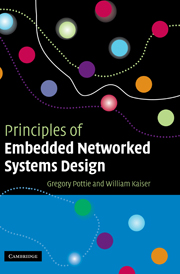Book contents
- Frontmatter
- Contents
- Preface
- Acknowledgments
- List of Abbreviations
- 1 Embedded network systems
- 2 Representation of signals
- 3 Signal propagation
- 4 Sensor principles
- 5 Source detection and identification
- 6 Digital communications
- 7 Multiple source estimation and multiple access communications
- 8 Networking
- 9 Network position and synchronization services
- 10 Energy management
- 11 Data management
- 12 Articulation, mobility, and infrastructure
- 13 Node architecture
- 14 Network data integrity
- 15 Experimental systems design
- 16 Ethical, legal, and social implications of ENS
- 17 Design principles for ENS
- Appendix A Gaussian Q function
- Appendix B Optimization
- Index
13 - Node architecture
Published online by Cambridge University Press: 10 August 2009
- Frontmatter
- Contents
- Preface
- Acknowledgments
- List of Abbreviations
- 1 Embedded network systems
- 2 Representation of signals
- 3 Signal propagation
- 4 Sensor principles
- 5 Source detection and identification
- 6 Digital communications
- 7 Multiple source estimation and multiple access communications
- 8 Networking
- 9 Network position and synchronization services
- 10 Energy management
- 11 Data management
- 12 Articulation, mobility, and infrastructure
- 13 Node architecture
- 14 Network data integrity
- 15 Experimental systems design
- 16 Ethical, legal, and social implications of ENS
- 17 Design principles for ENS
- Appendix A Gaussian Q function
- Appendix B Optimization
- Index
Summary
Conventional computing platforms include not just processors, memory, storage peripherals, and other peripherals associated with data processing, but also many interfaces (such as sound, imager, and mechanical input sensor systems) that have characteristics similar to systems specifically designed to interact with the physical world. An understanding of the architectures of such platforms is thus a good place to begin, in particular as many of the hardware and software design abstractions may usefully be applied to ENS nodes, just as many networking techniques and abstractions for general purpose computers apply to ENS. However, ENS applied to sensing applications requires architectural solutions that differ dramatically in several respects. For example, ENS platforms may be isolated from human users, may operate at low duty cycles, with deterministic schedules, and may be tolerant to a high communication error rate and long latency. At the same time, ENS may also be required to operate autonomously and unattended for extended periods on minimal battery energy. This is in marked contrast to embedded computing platforms of the past that directly support human users (e.g., cellular telephony platforms or handheld computing systems). For these applications, operations may not conform to deterministic schedules, operating lifetimes may be short, and administration by users is available. Of course, this example of low-duty-cycle operation represents merely one instance and others require widely varying ENS operating requirements; e.g., an image sensor may require a high sensor data rate and a high communication data rate.
- Type
- Chapter
- Information
- Principles of Embedded Networked Systems Design , pp. 394 - 438Publisher: Cambridge University PressPrint publication year: 2005



